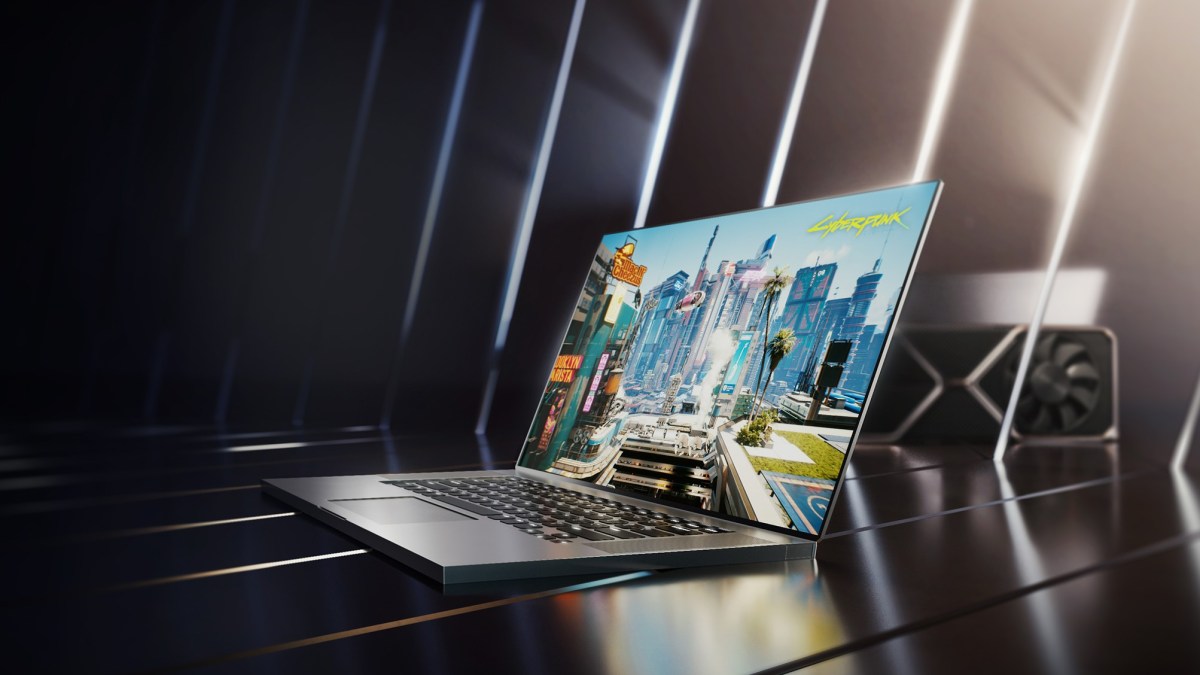How NVIDIA GeForce RTX 30 Series Laptops Supercharge Your Gaming
Ray tracing is the big draw, but there’s a lot more going on than you think in NVIDIA’s new GeForce RTX 30 Series laptops.

This article is presented by NVIDIA.
Ray tracing is a feature so graphically revolutionary that NVIDIA named a whole series of GPUs after it. And after a big impact in the desktop gaming PC space, NVIDIA next turned to laptops. RTX 20 series laptops brought a whole new world of power to PC gamers who no longer had to choose between portability and power.
Now NVIDIA has brought its Ampere architecture powered GeForce RTX 30 Laptop GPUs to the masses, and the results are as impressive as you’d expect from technology which the company describes as its “biggest generational leap ever.”
There’s more to it than just pretty lighting effects, though: RTX 30 Series laptops pump up the frame rates and reduce the volume, all while delivering up to twice the power efficiency of the previous generation – something that’s pretty darn important for gaming laptops.
To explore the full potential of GeForce RTX 30 laptops, I tested the state-of-the-art MSI GS66 Stealth. Suffice it to say, while it’s initially astonishing that such a thin and light device can be so powerful, things become clear when you see what’s inside. The included RTX 3080 GPU is given the perfect environment to thrive, with the GS66 also featuring a 10th-generation Intel Core i7 10870H processor, 16GB RAM, and a super-fast 1TB NVMe SSD.
Despite those beefy specs, the MSI GS66 lives up to its stealthy billing, at under 0.7 inches thick and tipping the scales at just 4.6 pounds. Not too shabby for a 15.6-inch laptop, especially one that’s capable of playing games at over 60fps in 1440p resolution with full ray tracing effects enabled.
I’ll be covering my experiences with the latest ray-traced games soon, but first, we need to talk about the technology under the surface that makes the RTX 30 laptop experience such a generational leap – and trust me, there are a few unsung heroes that don’t get as much attention as ray tracing.
Ray Tracing and DLSS Are Game Changers
Before I get into that, let’s quickly cover ray tracing for those yet to sample its delights. Ray tracing is an innovative technique used by game developers to render life-like lighting, shadow effects, and reflections accurately, making game worlds look more photorealistic than ever before. With ray tracing enabled, shadows emerge realistically from around corners in the dimly lit corridors of Cyberpunk 2077, while characters and objects beautifully reflect off Control’s Oldest House, just as they would in the real world. It’s breathtaking.
Ray tracing is, as you might have guessed from that brief explainer, incredibly taxing on compatible GPUs, and some people prefer to disable it to maximize their frame rates into three figures – especially if they’re esports professionals. Fortunately, with certain games, you don’t have to make the choice between frame rate and graphical fidelity anymore, thanks to a feature called DLSS.
DLSS – or Deep Learning Super Sampling to use its full name – is a really clever technology that uses the RTX GPUs’ Tensor Core AI processors to play at a higher resolution than its rendered at. In other words, while your RTX 30 laptop may be outputting at 2K or even 4K on screen, you get the same performance you’d get if your laptop was running at 1080p, just with more graphical niceties.
Read More About NVIDIA GeForce RTX 30 Series Laptops Here
This is a feature I’m extremely well acquainted with, as my desktop has an entry-level RTX 2060 powering things and DLSS really helps maximize performance, but it benefits top-of-the-range laptops like this as well. Using the same specs as the MSI laptop, NVIDIA found that Control, running at 1440p with high detail and max ray tracing, would run at a respectable 35.3fps with DLSS disabled, but shot up to 80.8fps with it switched on – an improvement of 129%.
You may assume that such a boost would result in a decline in image quality, but if there is one, then my eyes can’t see it. In fact, DLSS actually improves the quality of some games, as the video of Death Stranding demonstrates below. Not only does DLSS more than double the frame rate, but the text is far more readable on the AI-assisted version on the right. Impressive stuff.
A More Efficient Gaming Laptop
Not all features are as attention grabbing as DLSS, which means they run the risk of falling off the radar, but that would be a huge disservice to the many powerful 3rd generation Max-Q technologies at work with GeForce RTX 30 Series laptops. Take Dynamic Boost 2.0, for example, which tackles the problem of laptop power management. With a desktop PC, you can throw power at both the CPU and GPU to maximize performance, but laptops’ fixed power and thermal design makes this impossible.
Dynamic Boost 2.0 is the next best thing: AI detects where power is needed from moment to moment and automatically shifts it from GPU to CPU and back again as required. The result is not only improved performance and higher framerates but a significantly more power efficient laptop. It’s the very definition of “seen and not heard,” as it works so well that most gamers will never know it’s doing its job perfectly.
Powerful hardware in a thin laptop is usually a recipe for noise when the fans kick in, and that’s why NVIDIA has come up with WhisperMode 2.0. It’s not the tech firm’s first attempt to make gaming laptops more quiet, but it’s by far the most intelligent: rather than just reducing fan speed — which can lead to throttled performance — NVIDIA’s AI kicks in to match CPU power, GPU power, system temperature, and fan speed to the user’s chosen minimum frame rate. In other words, sound won’t just be reduced for its own sake: it’ll intelligently match the framerate you’re happy with.
Personally, I don’t mind a bit of fan noise, and I didn’t exactly find the MSI GS66 Stealth to be deafening anyway, but I can confirm that the feature works nicely. WhisperMode 2.0 audibly drops the decibels, and could be just the ticket for those trying not to irritate housemates with fan noise. NVIDIA puts the decision making power in your hands, and it works beautifully.
Then there’s NVIDIA Reflex, which looks to make latency as low as possible for the competitive gamer. Frankly, that doesn’t describe me, but it’s impressive all the same. The Reflex SDK has been enabled in competitive titles like Apex Legends, Valorant, Destiny 2, and Call of Duty: Warzone, and allows the CPU to submit work to the GPU just before it finishes the previous frame, killing the rendering queue. The result? Better response times, making it that much easier to quickly line up a headshot that could mean the difference between victory and defeat.
There’s one more feature I want to highlight which isn’t exclusive to the company’s RTX GPUs, but it’s so brilliant that I have to flag it: NVIDIA Highlights. If enabled by game developers, this clever software automatically records exciting moments of gameplay – incredible shots, match-winning plays, or desperate clutch kills. I play a lot of Hunt: Showdown, and at the end of every round, I find NVIDIA has carefully cataloged all my kills so I can save the best ones to easily share with friends. It’s simply genius.
All of these things, whether they’re obvious to the player or not, add up to a portable gaming experience that’s simply second to none. Many gaming laptops will make you pick between beauty and performance. With the new range of RTX 30 Series laptops, NVIDIA wants you to have both.
Learn more about NVIDIA’s GeForce RTX 30 Series laptops here.
